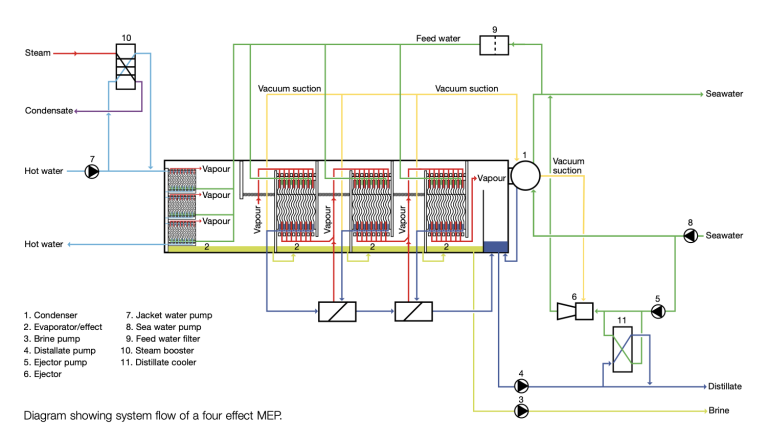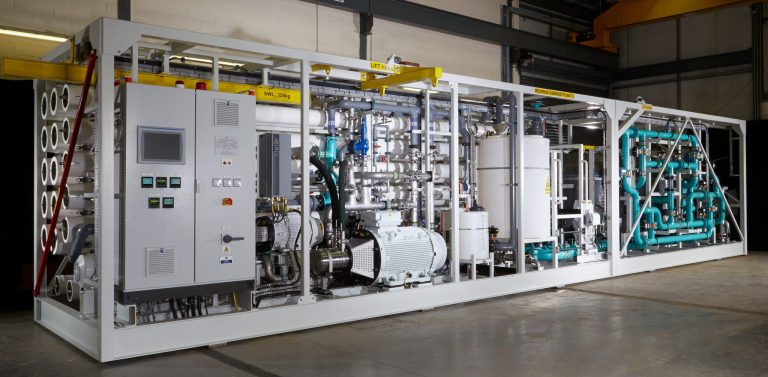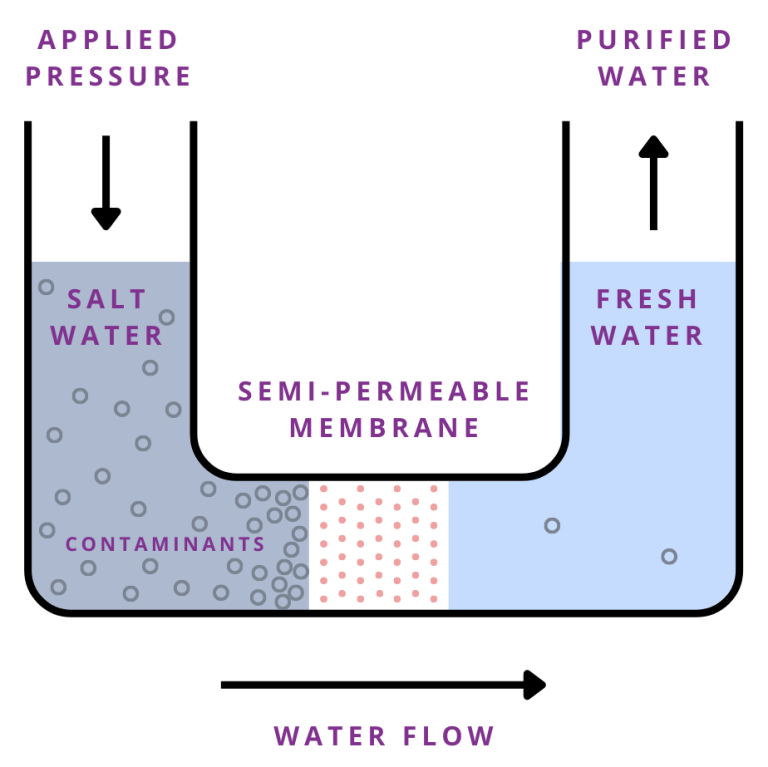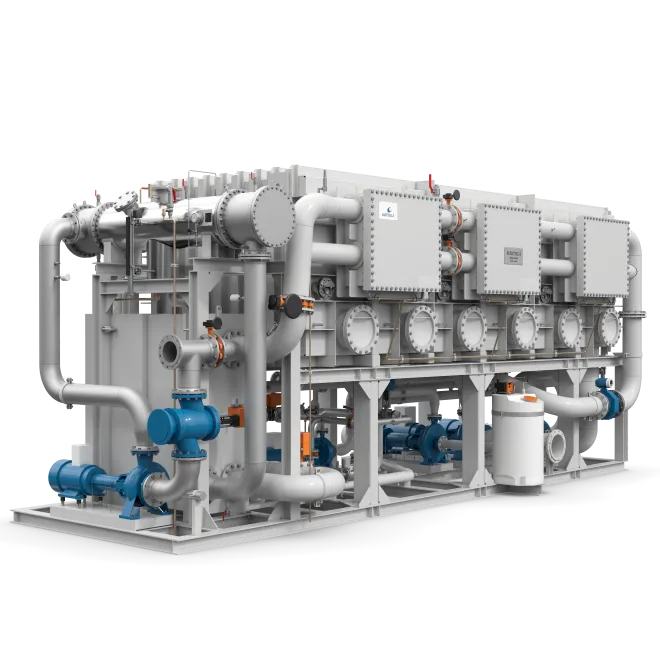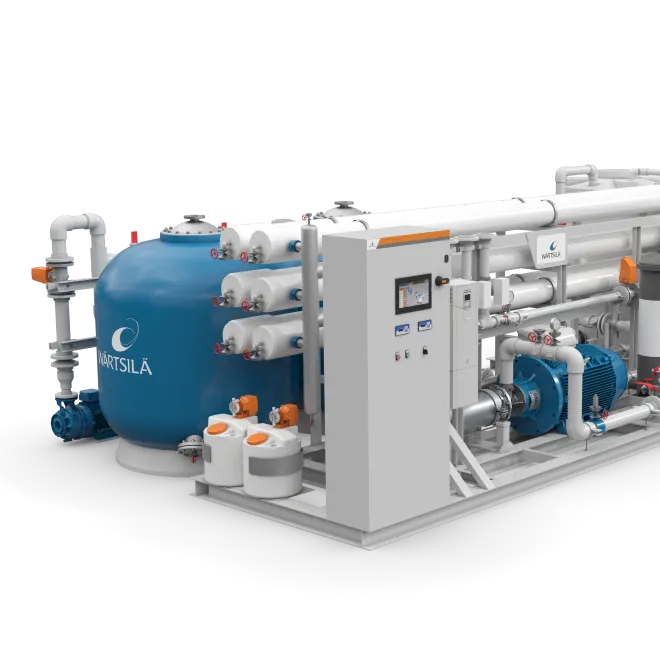Fresh water production on board cruise ships
The production of fresh water is a critical aspect of ensuring a comfortable and safe experience aboard cruise ships. With the vast expanse of the ocean surrounding them, cruise ships have ingeniously devised methods to transform seawater into potable water suitable for various uses onboard.
Two primary techniques employed for this purpose are reverse osmosis and evaporators. These technologies play pivotal roles in meeting the immense demand for freshwater required for drinking, cooking, cleaning, and other essential functions throughout the voyage. In this introduction, we will delve into the intricacies of both reverse osmosis and evaporators, exploring their processes, capabilities, and significance in sustaining life aboard these floating cities on the sea.
In the reverse osmosis process, seawater is pressurized and forced through a semi-permeable membrane, resulting in pure water permeate while most impurities are left behind. Alternatively, in evaporation, seawater is heated, and the resulting condensate is processed accordingly.
After desalination, the water undergoes further mineralization, disinfection, and storage before distribution throughout the ship. Various methods such as chlorination, ozonation, and UV radiation are utilized for disinfection.
Apart from these two mains methods, others, like bunkering, have been considered for water supply on cruise ships, but RO remains dominant due to its efficiency.
Evaporatore
Evaporators
Flash evaporators are indispensable components aboard cruise ships, with their size and placement being meticulously considered for optimal functionality. Conventionally, they occupy a significant footprint, longitudinally extending through the length of the compartment they inhabit. This strategic placement, often within or near engine compartments, serves multiple purposes critical to the ship’s operations.
Primarily, situating flash evaporators close to engine compartments maximizes the utilization of heat generated by the engines’ high-temperature cooling water. This arrangement ensures that the heat, which would otherwise dissipate unused, is harnessed efficiently in the water distillation process. Additionally, positioning the evaporators in proximity to the engines minimizes the need for extensive pipework and insulation, resulting in cost savings and streamlined installation. Moreover, the proximity to the engine compartment reduces the workload for high-temperature pumps and minimizes pressure losses within the system, thereby enhancing overall circulation efficiency. This optimized circulation is essential for maintaining the consistent operation of the flash evaporators, crucial for meeting the freshwater demands of the vessel.
The flash evaporation process itself is intricate and relies on a series of precisely orchestrated steps. It commences with the preheating of seawater using high-temperature jacket water sourced from the ship’s engines. The preheated seawater then enters the first-stage flash tank, which is maintained under vacuum conditions. In this environment, the seawater rapidly vaporizes, effectively removing salts and impurities. The resulting vapor is then directed through a demister and condensed back into distilled water, aided by the cooling effect of seawater, which absorbs excess heat. Simultaneously, the unevaporated water, now concentrated with salts, progresses to the second-stage flash tank, where the process is repeated, further purifying the water. This multi-stage approach ensures thorough distillation and purification of the seawater, resulting in high-quality distilled water fit for consumption. The distilled water is collected and stored, with its quality routinely monitored using specialized instruments like salinometers to ensure compliance with safety and quality standards.
While the process outlined here provides a simplified overview, modern onboard systems often incorporate additional stages and advanced technologies to optimize efficiency and output. These enhancements enable flash evaporators to produce freshwater at a rate of 20-25 m3/hr, subject to variations in seawater temperature and engine loads.
In essence, flash evaporators are indispensable assets in the maritime industry, playing a pivotal role in providing a steady and reliable supply of freshwater for the various needs of passengers and crew aboard cruise ships. Their integration into the vessel’s infrastructure underscores their importance in ensuring the comfort and sustainability of maritime operations.
Osmosi Inversa
Osmosi Inversa
Reverse Osmosis
Reverse Osmosis (RO) is a prevalent method for producing fresh water from seawater on cruise ships. Typically, an RO plant onboard is compact, with a smaller footprint compared to a flash evaporator, and has a capacity of 12-15 m3/hr depending on seawater quality and filter conditions. Cruise ships may have one or two RO plants based on their needs.
The RO plant process begins with seawater supplied by a low-pressure feed pump through a coarse strainer to remove medium-sized impurities. The water then passes through sand filters for further purification, removing solid particles and microorganisms. Backwashing of sand filters is necessary daily to maintain plant efficiency. Next, the water is treated with an antiscalant chemical to inhibit scale formation on RO membrane surfaces. Fine filtration follows in the cartridge filter, removing finer impurities before water reaches the membranes. High-pressure pumps then supply water to the membranes, operating at pressures of 50-70 bar to separate dissolved salts. The membranes, organized in 3-4 banks, produce clean freshwater as permeate and reject a solution of separated salts. The permeate joins the clean water outlet, while the reject undergoes further treatment before being discharged overboard.
Comparison between the methods
Each method has its advantages, limitations, and specific applications, making them complementary technologies in meeting the diverse water needs of passengers and crew. Below, we’ll compare these two systems across several key aspects:
1. Efficiency:
– Reverse Osmosis: RO systems are highly efficient in removing salts and impurities from seawater, producing high-quality freshwater suitable for drinking and various onboard uses. They can achieve freshwater recovery rates of up to 50-60%.
– Evaporators: Evaporators utilize heat to evaporate seawater, leaving behind salts and impurities. While effective, they are less efficient compared to RO systems, typically achieving freshwater recovery rates of around 25-30%.
2. Energy Consumption:
– Reverse Osmosis: RO systems require significant energy input to operate the high-pressure pumps necessary for forcing seawater through the membranes. However, advancements in pump technology have improved energy efficiency in recent years. The high-pressure pumps used in RO systems consume a substantial portion of this energy, typically ranging from 3 to 6 kWh per cubic meter of freshwater produced. Additionally, auxiliary equipment such as sand filters, cartridge filters, and mineralizers also contribute to the overall power consumption of RO plants.
– Evaporators: Evaporators consume less energy compared to RO systems since they primarily rely on heat for water evaporation. However, they still require energy for heating seawater and operating auxiliary equipment. evaporators rely on heat to vaporize seawater and subsequently condense the vapor to produce freshwater. The power consumption of evaporators is primarily driven by the energy required to generate and maintain the heat source. While the specific power consumption varies depending on the type and size of the evaporator, as well as environmental factors such as seawater temperature, typical power consumption ranges from 8 to 12 kWh per cubic meter of freshwater produced. Additionally, evaporators may also require energy for auxiliary equipment such as pumps and condensers.
3. Maintenance:
– Reverse Osmosis: RO systems involve intricate membrane filtration processes that require regular maintenance to ensure optimal performance. Membrane cleaning, replacement, and monitoring of system parameters are essential tasks.
– Evaporators: Evaporators are relatively simpler in design and maintenance compared to RO systems. Regular cleaning of heat exchangers and monitoring of system performance are typically sufficient to maintain operation.
4. Space and Installation:
– Reverse Osmosis: RO systems have a compact footprint, making them suitable for installation onboard cruise ships with limited space. They can be integrated into existing infrastructure with minimal modifications.
– Evaporators: Evaporators require more space compared to RO systems due to the need for heat exchangers and evaporator chambers. Installation may involve significant retrofitting or dedicated space allocation.
5. Water Quality:
– Reverse Osmosis: RO systems produce high-quality freshwater with low salinity and minimal impurities, meeting stringent potable water standards. The water is suitable for drinking, cooking, and other onboard uses.
– Evaporators: While evaporators effectively remove salts and impurities from seawater, the quality of freshwater produced may vary depending on system design and maintenance. Additional treatment may be required to meet potable water standards.
Evaporatore
Evaporatore
Water usage & storage
Fresh water management is a critical aspect of ensuring a comfortable and safe experience for passengers aboard cruise ships. From drinking to bathing and sanitation, access to clean and potable water is essential. One of the key components of this process is the delivery of fresh water from potable water tanks to individual cabins, a journey that involves several steps to maintain quality and efficiency.
At the heart of the fresh water delivery system on cruise ships are the potable water tanks. These tanks, typically made of corrosion-resistant materials like stainless steel, are carefully monitored and maintained to meet stringent health and safety standards. Before embarking on a journey, the tanks are filled with treated water sourced from shore-based facilities or produced onboard through advanced desalination or purification systems. Before entering the PW tanks and whatever the system used, the produced water, requires additional treatment for consumption. Mineralizers filled with minerals such as calcite adjust taste, pH, and hardness, making water safe for consumption. Carbon dioxide is often added to control pH during re-mineralization. Chlorine is dosed to disinfect the water, with its concentration regularly monitored to meet USPH standards. Some ships may use acid dosing for pH control. After mineralization, chlorination, and pH treatment, the water is stored in potable water tanks, ensuring ship stability. Consumption from the tanks follows a specific order to allow chlorine to settle, with residual chlorine content checked before use. Water for consumption must also meet chlorination standards, typically exceeding USPH requirements to ensure compliance.
Once the ship sets sail, the water in these tanks becomes the primary source of fresh water for passengers and crew alike. To ensure that this water remains safe for consumption, it undergoes regular testing and treatment procedures. This includes filtration to remove impurities, disinfection to kill harmful bacteria and viruses, and pH adjustment to maintain optimal quality. When a passenger turns on the faucet in their cabin, the journey of fresh water from the tanks begins. The water is pumped through a network of pipes that run throughout the ship, delivering it to various outlets such as sinks, showers, and toilets. Along the way, pressure regulators and valves help control the flow and distribution of water to different parts of the vessel.
To further enhance water efficiency and conservation, modern cruise ships are equipped with advanced technologies such as low-flow faucets and showers, as well as sensor-based systems that automatically shut off water when not in use. These measures not only help reduce water consumption but also contribute to the sustainability goals of cruise lines.
In conclusion, both reverse osmosis and evaporators play vital roles in freshwater production onboard cruise ships, offering distinct advantages and challenges. While RO systems excel in efficiency and water quality, evaporators provide a reliable alternative with lower energy consumption. The choice between these technologies depends on factors such as space availability, energy efficiency goals, and water quality requirements. The potable water system, on the other hand, represents one of the most complicated and delicate systems due to the need to supply water to over a thousand cabins, potentially simultaneously, both hot and cold water. Therefore, correct design is fundamental, but above all, proper management of the system is essential to ensure that it is always efficient and operational.
Don’t miss further news, information and advice on the world of cruises on Cruising Journal.

